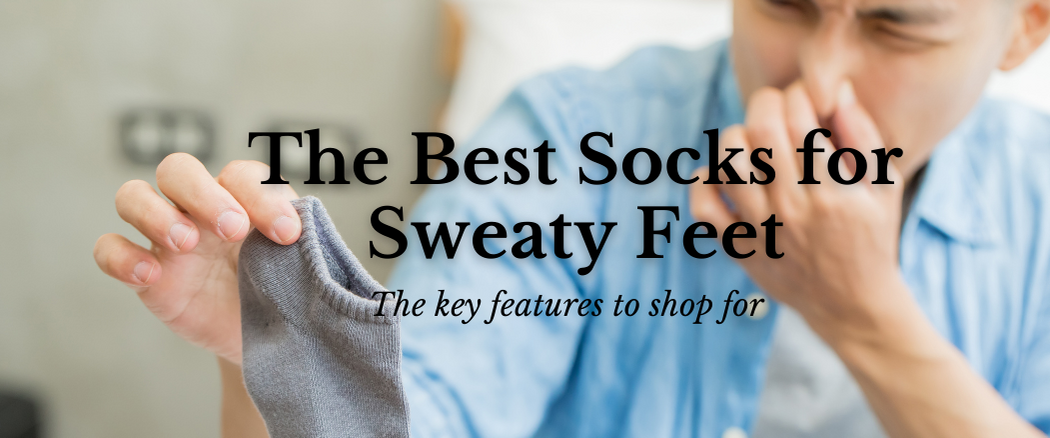The Best Socks for Sweaty Feet | Here's the key features to look for
Sweaty feet are a real stink, I know, and it can lead to a heap of issues like cracked skin, redness and smelly socks and shoes. Not ideal. Fortunately though, there are ways to reduce and even prevent sweaty feet building up and wearing the best socks for sweaty feet, or should I say the best socks for stopping sweaty feet, is a big factor.
At Creepers, we’re a sock company that puts feet first. Socks that are designed form the ground up top boost foot health, comfort and function. We now what features, materials and specs are key in socks and have laid them out here for you so that wherever you buy your socks from, you can choose the best for those feet of yours.
Ps. I’ll try and not let my bias towards our awesome sweat-busting socks shine through… and if you want to skip the what and why and go straight to our top 5 recommendations for the best socks fro sweaty feet, skip to our next post here.

What Causes Sweaty Feet?
Your feet have more sweat glands per inch, than any other area of your body. Take this and the fact that for a lot of the day we typically wear the double whammy of socks and shoes, it’s a recipe for a hot, sweaty environment. Most shoes are thick and really don’t breathe well and chuck a sleepign back for your foot in there (your socks) and your feet loose the ability to regulate temperature well - Which they usually do through persipiring!
You see, sweat isn’t a bad thing. It’s not the enemy. It’s a natural process to help cool us down.It gets a bad rap and sure it can be a bit gross at times and lead to unwanted sweaty patches and smell but it’s very, very crucial in preventing us form overheating - so lets not stop it.
I actually had someone comment recently that they stop their feet sweating by putting antiperspirant deodorant on their feet! Stopping your body sweating, stops your body effectively cooling down - we don’t want to stop that natural process - please, don’t do this.
There’s a bunch of things that change how much we sweat and most of them are not easy to change:
- Body size: The bigger you are, the more heat generated because more mass is needed to be moved (the engine works herdm,der creates more heat and so, more sweat.
- Age: You handle heat less as you age due to sweat glands reducing the ability to cool you down as effectively.
- Muscle mass: Muscle make more heat than fat because it’s actively working, so sweeat rate can also depend on muscle mass.
- Health status: There a lot of health issues that can change how musch you sweat, from medications or the cold and flu to hormonal changes or mental health conditions like anxiety.
- Fitness level: If you’re active you sweat more because your body is working harder and creating more heat. But, if an unfit person and a fit person were doing the same exercise or task, the less-fit person would sweat more(ref).
Most of these things, they’re aren’t easy or fast to change and we don’t want to stop you sweating (it’s natural), but help the sweat evaporate away as efficiently as possible. Sure, you can try avoid triggers such as caffeine, hot drinks and spicy foods but really, for most people, the issue isn’t sweating, it’s the sweat building up.
We sweat to cool ourselves down and the hotter we are, the more we sweat. As the sweat evaporates, heat is drawn from our skin.
If your sweat can’t evaporate away well enough, it builds up. If you were in bare feet all day, sure the sweat would evaporate away naturally and easily, but in the double whammy of socks and shoes, it just doesn’t happen as easily.
That’s why it’s crucial to pick socks that allow for your sweat to be both drawn away from your skin and then evaporated and further down in the article, I’ll get to just what to look for.
What Issues do Sweaty Feet Cause?
- Athletes foot: It’s fungal skin infection that can spread easily. It’s common in those whose feet regularly get sweaty for long periods of time in restrictive or narrow socks and shoes.
- Sweat rash
- Redness
- Dry, cracked skin
- Blisters
- Smell
Can Socks help with Sweaty Feet?
Yes, and no. The right socks can definitely help reduce or prevent sweaty feet.
Our skin is the largest organ in our body and letting it sweat to then be evaporated to cool us down, is important. Socks that help draw the sweat away form the skin, closer to the air are going to really help that evaporation - leading to healthier, dryer skin.
There are a number essential sock features to help moisture be drawn away from the skin and if you can find a sock that combines them, and is comfortable to you, sweaty feet will be much less of a problem for you!
The Best Socks for Sweaty Feet | Essential Features
1. Material matters.
A combination of moisture wicking synthetic yarn and anti-bacterial, temperature regulating merino wool is the best combination.2. Breathable mesh
For increased breathability and air-skin contact and effective evaporation
3. Lightweight with minimal padding
This allows sweat to wick away and evaporate fastest. Padding is NOT what you want.
4. Natural foot shape or separate toes
Improve breathability and reduce sweat between yours toes - this is last, but certainly not least.
These features are broken down in more detail below.

Material.
Yarn composition is at the top of the list for a bloody good reason - it will make or break the effectiveness of your socks in reducing sweat.
Synthetics yarns play an important role in reducing sweat. They are moisture hating (hydrophobic), so if excess moisture comes in contact with them, it doesn’t absorb in, but is drawn through, between the fibers to then be allowed to evaporate. This is called moisture wicking - it wicks the moisture away from the surface of the skin, towards the the surface of the socks and closer to the air so that it can be evaporated.
Natural fibers are a different kettle of fish altogether, with some being bloody excellent for sweaty feet, but others only add to the problem
Merino Wool is excellent for reducing sweat. The outer layer of each fiber is hydrophobic ( water hating), keeping yoru skin dry, and what is really cool is that the inner core is hydrophilic (water loving) and actively draws water away from your skin and into the center. It can hld up to 30% of it’s weight in water, keepign your skin drier and also as the moisture evaporates from the yarn, cools your skin. Merino is also found to be faster drying that synthetic yarns with research sowing it drying faster than Coolmax or polyester(ref). And finally, the other naturally awesome feature of merino is the microscopic little scales on the (very fine) wool fibers. These little scales won’t let bacteria embed on the surface, helping stop the socks becoming smelly - it’s the ultimate odorless fiber for healthy skin.
Alpaca wool has some benefits similar to merino , yes only absorbs upt o 10% of it’s weight due to having a semi-hollow core. It also doesn’t have the scales on the fibers to reduce bacteria, so in terms of sweaty feet and smell, it comes in second place behind merino. Where it comes up trumps is luxurious softness due to it’s smooth surface and insulation (warmth) provided by the semi-hollow core.
Cotton is used in a lot of socks. That’s an understatement, it’s used in most everyday socks, and for good reason. There’s also very good reasons that it isn’t used as much in sports socks and why you, if you want to reduce sweaty feet, should avoid it as well.
First the positives. Cotton is soft initially, yes and it is also a natural fiber that breathes easily, helping regulate temperature. It’s also biodegradable and abundant, making it cheap and creating affordable socks.
Here’s the negatives though, for those that battel sweaty feet. It absorbs moisture easily and unlike merino wool, is entirely moisture-loving (hydrophilic), leaving a moist fiber in contact with your skin, rather than absorbing it or wicking it away. After absorbing moisture, the moist fabric against your skin keeps your feet cold and add to this, the retained moisture against your skin can cause blisters and skin redness if used for a while. Last but not least, cotton socks also get stiffer (more friction), retain bacteria and loose shape, having to be replaced more often.

Breathable
Having a more open material as well as a mesh upper foot, increases the breathability and improves your skins ability to evaporate sweat by increasing the area of skin in contact with air.
A sock made with a 144 needle count vs a 200 needle count for example, will have a more open construction. Add to this a mesh window at the top of the foot and you allow more heat to escape, resulting in less sweat, and you’re onto a winner.

Lightweight and No Padding
So often, athletic socks have padding or increased sock thickness for comfort and yes, it may be more comfortable initially but for those that want to reduce blisters or sweat, you will want to go in the opposite direction. Thicker socks take longer to wick moisture away and are more likely to retain heat and sweat. Complicating things ehre is that thicker socks tend to bunch up more often and not stay in place. Research has shown that socks with terry knit padding cause more friction that single layer, non padded socks and so increase the risk of blisters (ref).
Let Your Toes Splay and Breathe
The most common place for skin redness, blisters, athletes foot an adjust clammy, sweaty and smelly skin, is your toes.
This is where there is where, in standard socks, there is most skin on skin contact and poor breathability. The majority of everyday and sports socks are narrower than your feet and have 2-5% elastic component in them, resulting in a pull-together force on your toes.
To let sweat evaporate better and for drier, healthier toes, you need to ensure your socks are working with you and allowing your toes to sply optomially, rather than working against you, squishing yoru toes together. Choosing socks with a natural foot shape, that isn’t too restrictive for you toes is essential in the most sweat prone area of your foot.
You can take this a step further though and not only choose socks that allow your toes to splay, align naturally and breather but wrap each toe in moisture wicking fabric with toe socks.
Seamless toe socks immediately remove the skin on skin contact and improves the toe spacing and moisture wicking.

Conclusion
It’s not just about, how you can stop your feet sweaty. That’s not an easy fix and you shouldn’t try to stop a natural process. What we really want to do to reduce sweaty feet is to allow and optimize sweat evaporation and hence reducing sweat build up, heat, smell, increased friction and even athletes foot.
Choosing socks that are lightweight, breathable and with a blend of merino and synthetic yarns that are best at both drawing moisture away from the skin and drying fast is essential in a sock for reducing sweaty feet.
Check out why THESE merino blend toe socks have got over 100 five star reviews about their awesome ability to reduce sweat, blisters and improve foot comfort, or check our our next post in this sweaty feet series for our top 5 recommendations of the best five socks for sweaty feet.

